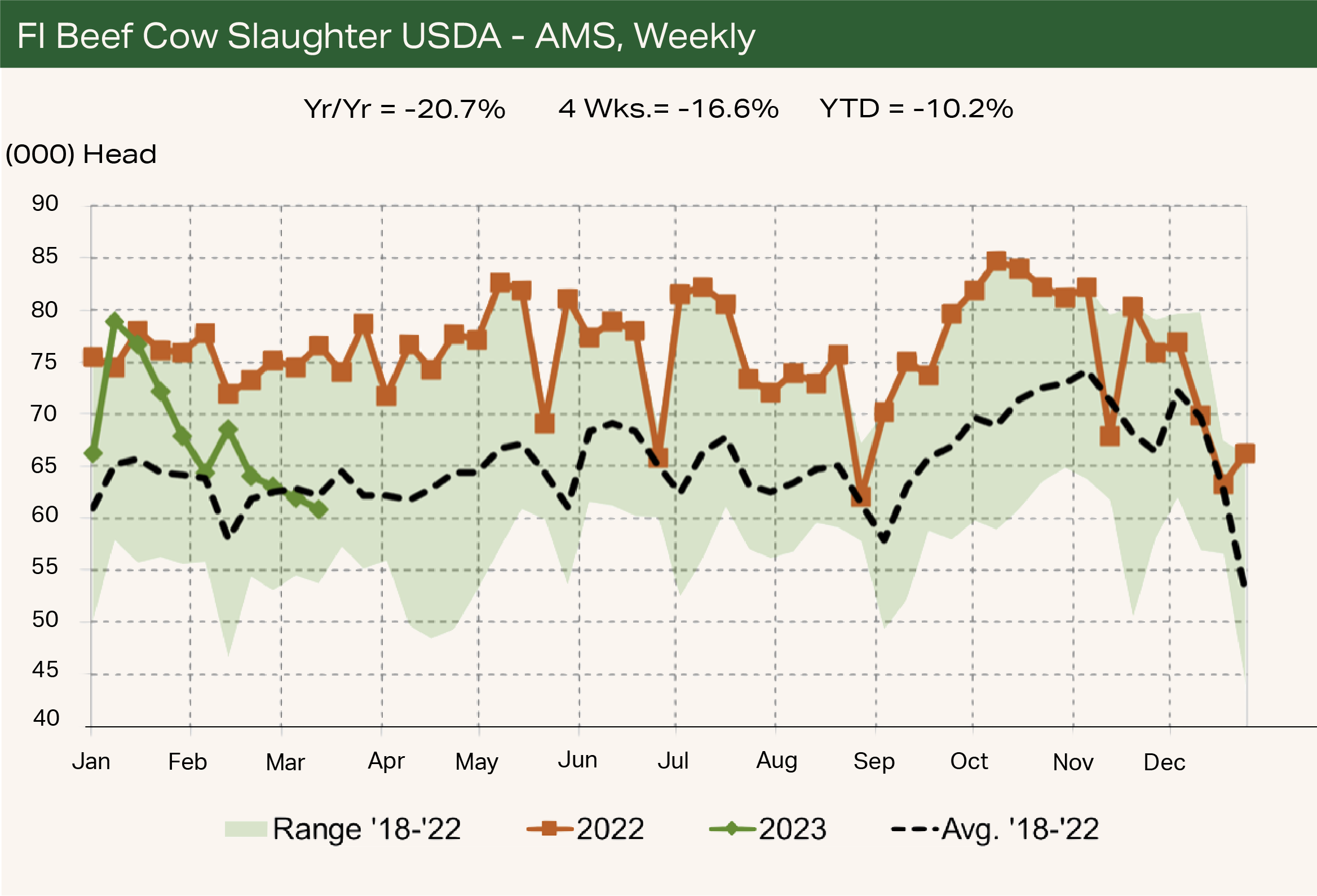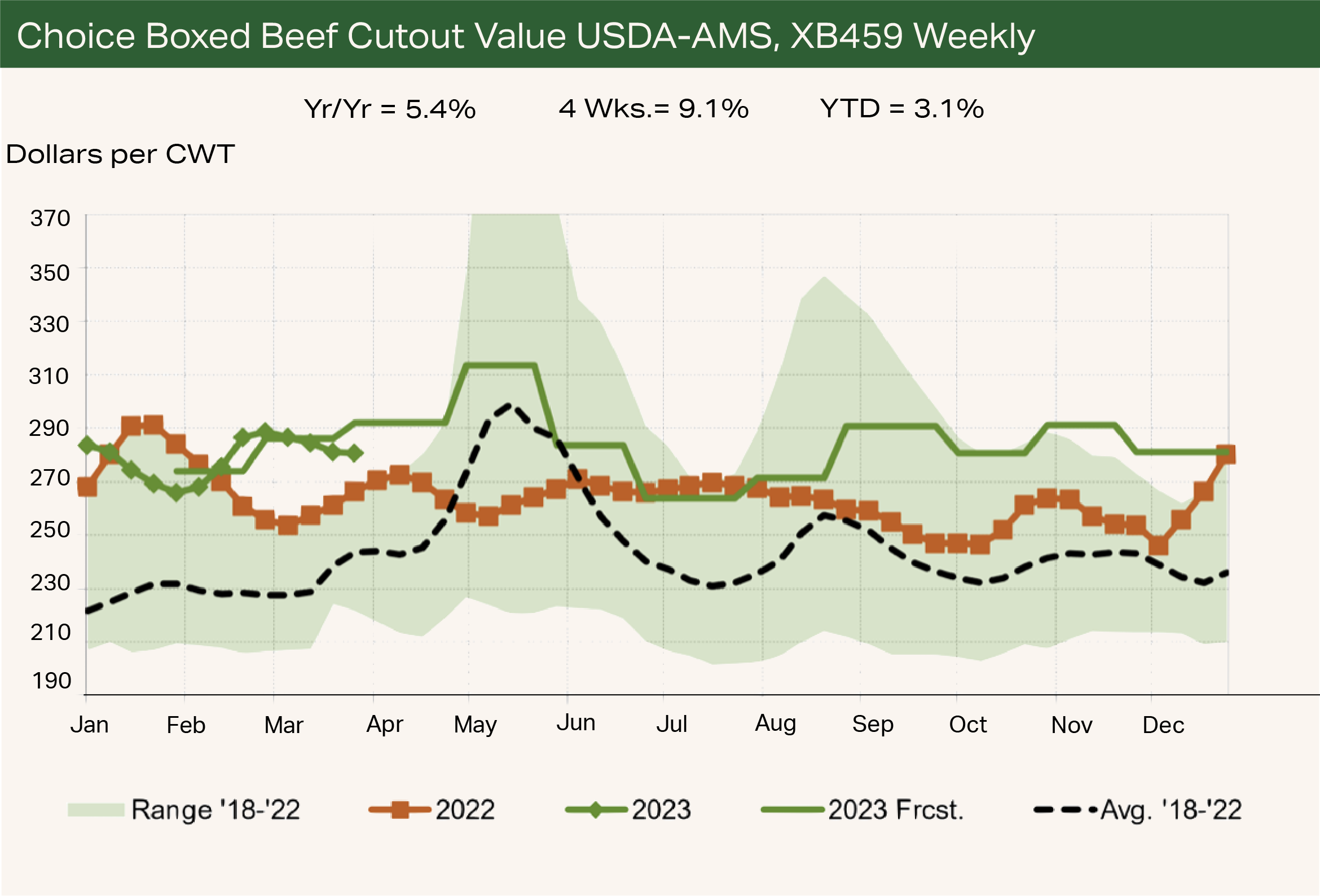Production Forecast
U.S. beef cattle slaughter was down about 4% year-over-year (YOY) in the first part of 2023, resulting in lower beef production by about 5% YOY. In 2023, annual cattle slaughter and beef production were down 4.25% to 4.75% versus 2022.
Price Forecast
Fed cattle prices in the second quarter of 2023 have seen their highest weekly average levels since the week ending January 10, 2015, with only several dollars per hundredweight left to reach or exceed records set in 2014. Fed cattle prices are expected to be steady to lower through the quarter. Choice and Prime beef demand remains on solid footing with cutout values nearly 10% above the highs set in 2014 to 2015.
Total cattle inventories started the year down 3% YOY while beef cow numbers were down 3.6%. USDA estimated the 2022 calf crop to be 34.46 million head, a decline of about 2% YOY. This was the smallest annual calf crop total since 2015. In 2022, beef cow slaughter was up 10.9% YOY. This has moderated to near five-year average levels since the first few weeks of 2023. First quarter beef cow slaughter was down 10.2% YOY, which was still 7.5% above the previous five-year average.
This is due to the drought-reduced number of beef replacement heifers kept in 2021, bred in 2022 and expected to calve in 2023. This year is expected to mark the fewest beef replacement heifers calving and entering the beef cow herd since 2005.

Equatorial Pacific Ocean sea-surface temperatures have returned to neutral levels, signaling the departure of La Niña conditions. The odds are increasing that El Niño conditions could return by late Q3 to Q4 2023. This warming trend is expected to continue bringing much-needed moisture to the rest of the Southwest and central Plains, but not in the form of atmospheric rivers seen in central and southern California.
El Niño conditions are associated with drought conditions in Australia and parts of New Zealand. Very favorable La Niña moisture and grazing conditions in Australia, combined with constrained slaughter capacity, have led to booming cattle numbers that will need to move off pastures when drought returns late this year or in 2024. As Australian grass-finished slaughter capacity increases, exportable supplies will likely have a welcome reception in the world market as U.S. beef supplies and beef cow slaughter decline amid our herd rebuilding.
Cattle inventories in U.S. feedlots are expected to begin Q2 2023 down 4.5% to 5% YOY, marking five-year lows. Fed cattle availability is expected to decline at a faster-than-seasonal pace through the summer months, due to limited supplies of cattle coming off winter and small-grain grazing programs, and the expected decline in feedlot placements.
Tighter fed cattle supplies are expected to continue supporting prices, allowing packers to push those higher prices into the wholesale beef market. Packers have seen only limited success in this effort so far in late Q1 and early Q2 2023, with Q1 gross margins roughly $250/head narrower YOY. As replacement cattle numbers tighten due to a smaller calf crop and eventually drop further as heifer calf retention surges (likely in fall 2023) to begin rebuilding, I expect values for feeder cattle and calves to continue rallying with only the occasional, but cyclically smaller, seasonal break to the market.
Cattle and beef market participants continue to look over their shoulders, watching for demand erosion and faltering markets due to inflationary pressures and declining consumer spending and sentiment. However, the fed cattle and boxed beef markets have been outperforming our previous expectations by about $5/cwt and $10/cwt, respectively.
As a result, we have increased our forecast for fed cattle prices for 2023 to average $160/cwt to $165/cwt on a live basis. The seasonal summer decline in fed cattle markets is expected to be smaller than normal, and the rally to fall and early winter highs could put prices into the mid-$170s. Feeder cattle and calf markets will remain undersupplied with prices rallying at every opportunity.

Terrain content is an exclusive offering of AgCountry Farm Credit Services,
American AgCredit, Farm Credit Services of America and Frontier Farm Credit.